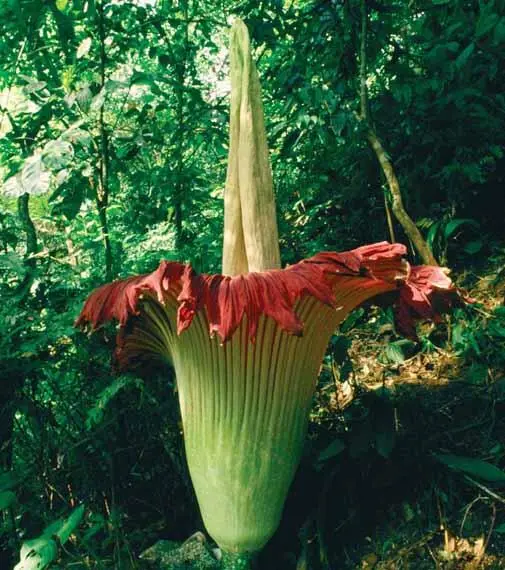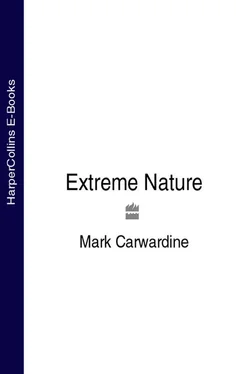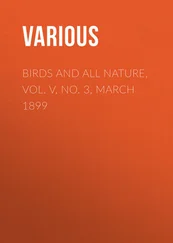| NAME |
sawfish Pristis species |
| LOCATION |
shallow, warm coastal waters |
| ABILITY |
using its saw for slashing and sifting |
© Marty Snyderman/imagequest3d.com
A sawfish has external teeth, set around a sensitive, flat snout – the saw, or rostrum (here shown from the underside). Swung from side to side, the saw can be used as a powerful weapon to slash shoaling fish such as mullet and herring, which it then eats off the sea-bottom. Generally speaking, though, the sawfish is a slow and peaceable animal, spending its time in shallow, muddy water, raking the mud with its saw for crustaceans and other prey. The saw-teeth get worn by all this grubbing, but they grow continuously from their bases and so don’t wear out.
Like its close relatives, the rays, it’s perfectly camouflaged against the bottom of the sea, and like its more distant relatives, the sharks, it swims in an undulating way. And like both groups, its hard bits are cartilage, not bone, and its teeth are adapted scales. It has another similarity. Using special cells, the ‘ampullae of Lorenzini’, on its saw and head, it can detect electrical fields generated by prey.
One problem for females is that they give birth to live saw-babies. But a youngster’s saw is covered with a sheath to make birth relatively painless. A much greater problem for all sawfish (possibly seven species) is the fact that their coastal waters are being polluted and developed and that they have been overfished to the point where all are endangered, some critically. A sawfish’s saw is also its downfall. Not only has it been sought after as a trophy, but it also fatally entangles the fish in nets.
| NAME |
titan arum, corpse flower, or devil’s tongue, Amorphophallus titanum |
| LOCATION |
western Sumatra, Indonesia |
| ABILITY |
pumping out the smell of decomposing flesh |

© Neil Lucas/naturepl.com
What smells bad to us often doesn’t bother other animals. In fact, the scent of the foul-smelling titan arum – the tallest and probably heaviest of flowering structures – is positively attractive to carrion beetles and bees. Whether its smell is the worst, to us, has still to be tested (there are other contenders for this, including the even bigger giant titan, A. gigas ). But the titan arum produces a sufficiently awful smell to make people faint.
The ‘flower’, or inflorescence, comprises a vase-shaped spathe (petal-like leaf) at least 1.2m (4ft) tall, which grows rapidly from a gigantic tuber weighing up to 80kg (177lb). Out of this rises a spadix, a spike with thousands of tiny flowers more than 2.4m (8ft) tall, so strange it gives the arum its scientific name: ‘huge deformed penis’. The upper part of the spike produces the smell, and to make it travel further, the spadix generates heat and may steam at night as it pulses its fragrance of ammonia, rotting flesh and bad eggs for up to eight hours at a time.
This attracts pollinating, carrion-loving insects, but few people have observed the pollination, probably because the plant flowers only every 3–10 years and then for just two days. Once the flower dies and hornbills have dispersed its seeds, it’s replaced by a titanic leaf up to 6m (20ft) tall, which makes the food so that, one day, the tuber can grow another stinking flower.
| NAME |
Chatham Island black robin Petroica traversi |
| LOCATION |
Chatham Islands, east of South Island, New Zealand |
| ACHIEVEMENT |
increasing in numbers from just five to 250 in 18 years |
© Don Merton
New Zealand’s Chatham Islands are believed to have been the last Pacific archipelago to be visited by humans. Yet when people finally did visit, they stayed, and they did a pretty thorough job of doing what humans have always done to islands: stripped them of a lot of their native plants and animals. The Polynesians arrived around 700 years ago, the Europeans came along in the 1790s, and between them they caused the extinction of 26 of the islands’ 68 species and subspecies of birds. The main cause was introduced land mammals, and among the sufferers from cats and rats in particular was the 15cm (6in) endemic black robin.
By 1900 it had disappeared from the two main islands and survived only on Little Mangere, a tiny, windswept stack with sheer cliffs that helped keep predators away but didn’t offer the birds much protection from the elements. By 1972 only 18 were left. By 1976, seven.
In the meantime, though, the government had bought nearby Mangere Island and begun to reforest it, and all the birds were moved there. Nevertheless, by 1980, there were just five, with only one breeding pair. But by fostering eggs to other bird species on other islands – which improved the survival chances of the chicks and spurred the breeding female to nest again – conservationists painstakingly cranked the species back to life. Now there are about 250 black robins on Mangere and South East islands, and there are plans to repopulate other islands in the Chathams.
| NAME |
Pompeii worm Alvinella pompejana |
| LOCATION |
deep-sea hydrothermal vents |
| ABILITY |
withstanding scalding water |

© Peter Batson/imagequest3d.com
The Pompeii worm thrives in large colonies in one of the darkest, deepest, most hellish places on Earth – close to a geyser of water so hot it could melt the worm in a second. It is also subject to a pressure great enough to crush a person and doused in a soup of toxic sulphur and heavy metals. Communities of Pompeii worms cling to the sides of ‘smokers’ 2–3 km (1.2–1.9 miles) under the sea. These belching chimneys grow over hydrothermal vents on volcanic mountain ranges, created from the chemicals that precipitate out as 300°C (572°F) vent water meets cold seawater.
To survive on a smoker requires super-worm strategies. For its home, the worm makes a paper-like chemical-and-heat-resistant tube. For a thermal blanket, it ‘grows’ a fleece of filamentous bacteria, feeding it with sugar-rich mucus secreted from its back. This blanket may also detoxify the vent fluid in its tube.
Unlike the vent tubeworm Riftia pachyptila , the Pompeii worm has a gut and ‘lips’ which it extends to ‘graze’ on bacteria that grow on the surface of the colony. But no one knows quite how it copes with what are the highest temperatures and temperature gradients experienced by any organism apart from bacteria, for though it angles its head (gills, mainly) away from the hottest water, its tail experiences flushes hotter than 80°C (176°F). Keen to make use of the Pompeii worm’s technology for human endeavours, scientists are now racing against each other to unravel its survival secrets.
Читать дальше












![Various - Birds and Nature Vol. 11 No. 3 [March 1902]](/books/745532/various-birds-and-nature-vol-11-no-3-march-1902-thumb.webp)
![Various - Birds and Nature Vol. 9 No. 3 [March 1901]](/books/745788/various-birds-and-nature-vol-9-no-3-march-1901-thumb.webp)